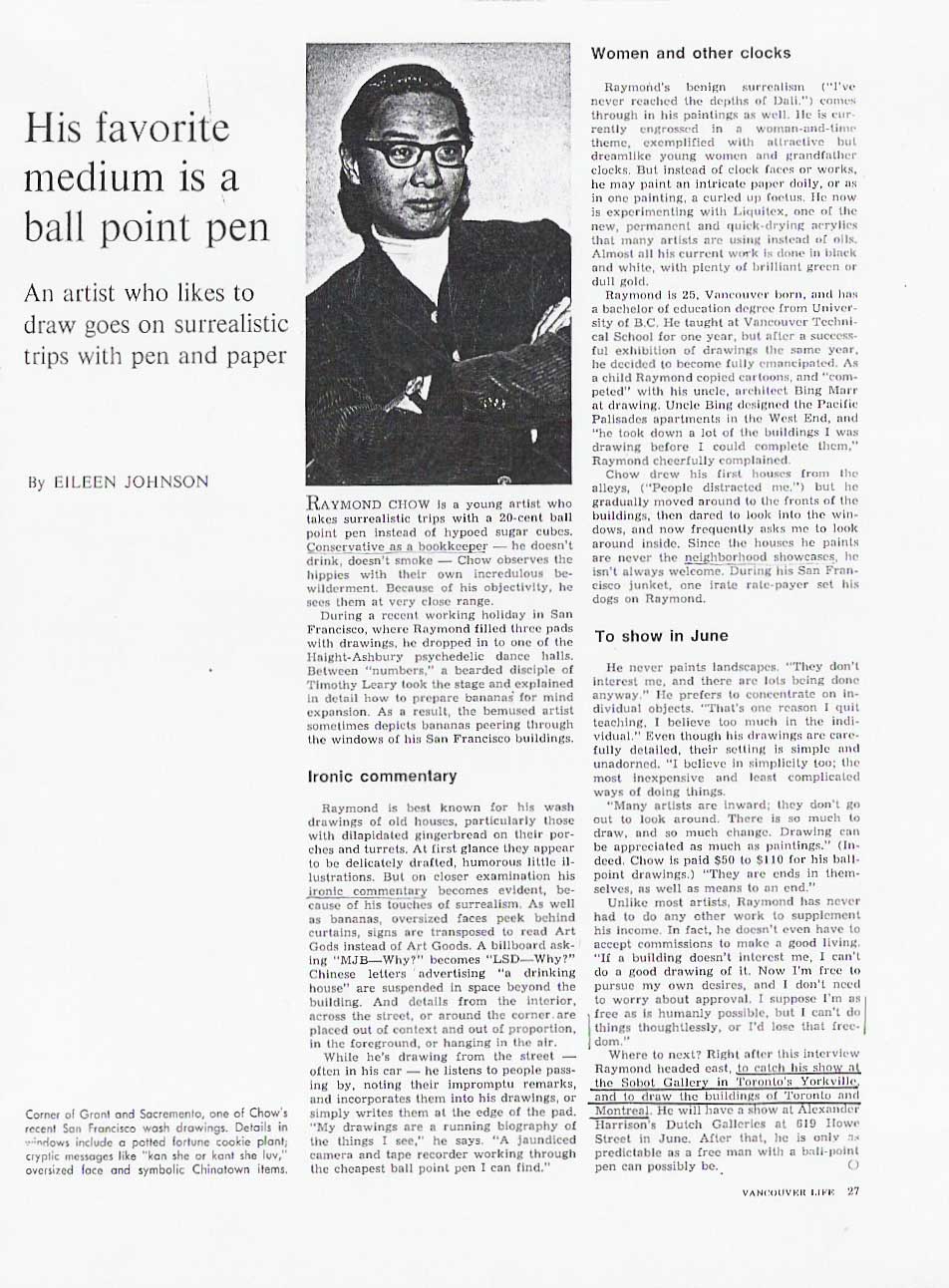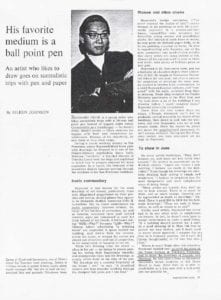
Ball Point Pen – 1966 Vancouver Life Article

Ball Point Pen
His favorite medium is a ball point pen
An artist who likes to draw goes on surrealistic trips with pen and paper
By EILEEN JOHNSON – 1966
RAYMOND CHOW a young artist who takes surrealistic trips with a 20-cent ball
point pen instead of hypoed sugar cubes — he doesn’t drink, doesn’t smoke — Chow observes the
hippies with their own incredulous bewilderment. Because his objectivity, he sees them at very close range.
During a recent working holiday in San Francisco, where Raymond filled three pads with drawings, he dropped in to one of the Haight-Ashbury psychedelic dance halls. Between ‘numbers,” a bearded disciple of Timothy Leary took stage and explained in detail how to prepare bananas for mind expansion. As a result, the bemused artist sometimes depicts bananas peering through the windows of his San Francisco buildings.
Ironic commentary
Raymond is best known for his wash drawings of old houses, particularly those with dilapidated gingerbread on their porches and turrets. At first glance, they appear to be delicately drafted, humorous little illustrations. But on closer examination his ironic commentary becomes evident, because of his of touches of surrealism. As well as bananas, oversized faces peek behind curtains, signs are transposed to read Art Gods instead of Art Goods. A billboard asking “MJB – Why?” becomes “LSD—Why?”
Chinese letters advertising “a drinking house” are suspended in space beyond the building. And details from the interior, across the street or around the corner are placed out of context and out of proportion, in the foreground, or hanging in the air.
While he’s drawing from the street – often in his car – he listens to people passing by, noting their impromptu remarks, and incorporates them into his drawings, or simply writes them at the edge of pad.
“My drawings are a running biography of the things I see,” he says. “A jaundiced camera and tape recorder working through the cheapest ball point pen I can find.”
Women and other clocks
Raymond’s benign surrealism (“I’ve never reached the depths of Dali.”) comes through in his paintings as well. He is currently engrossed in a women-in-time theme, exemplified with attractive dreamlike young women and grandfather clocks. But instead of clock faces or works, he may paint an intricate paper doily, or as in one painting, a curled up fetus. He now is experimenting with Liquitex. one or the
new, permanent and quick-drying acrylics many artists using instead of oils. Almost all his current work is done in black and white, with plenty of brilliant green or dull gold.
Raymond is 25, Vancouver born, and has a bachelor of education degree from University of B.C. He taught at Vancouver Technical School for one year, but after a successful exhibition of drawings the same year, he decided to become fully emancipated. As a child Raymond copied cartoons, and ”competed” with his uncle, architect Bing Marr at drawing. Uncle Bing designed the Pacific Palisades apartments in the West End, and “he took down a lot of the buildings I was drawing before I could complete them,” Raymond cheerfully complained.
Chow drew his first houses from the alleys, (“People distracted me.”) but he gradually moved around to the fronts of buildings, then dared to look into the windows, now frequently asks me to look around inside. Since the houses he paints are never the neighbourhood showcases, he isn’t always welcome. During Sin Francisco junket, one irate rate-payer set his dogs on Raymond.
To show in June
He never paints landscapes. “They don’t interest me, and there are lots being done anyway,” He prefers to concentrate on individual objects. “That’s one reason I quit teaching. I believe too much in the individual.” Even though his drawings are carefully detailed, their setting is simple and unadorned. “I believe in simplicity too; the most inexpensive and least complicated ways of doing things.
“Many artists are Inward; they don’t go out to look around. There is so much to draw, and so much change. Drawing can be appreciated as much paintings.” (Indeed Chow is paid $50 to $110 for his ballpoint drawings.) “They are ends in themselves, as well as means to an end.”
Unlike most artists, Raymond has never had to do any other work to supplement his income. In fact, he doesn’t even have to accept commissions to make a good living. “If a building doesn’t interest me, I can’t do a good drawing of it. Now I’m free to pursue my own desires, and I don’t need to worry about approval. I suppose I’m as free as is humanly possible, but I can’t do things thoughtlessly or I’d lose that freedom.
Where to next? Right after this interview Raymond headed east, to catch his show at the Sobot Gallery in Toronto’s Yorkville, and to draw the buildings of Toronto and Montreal. He will have a show at Alexander Harrison’s Dutch Galleries at 519 Howe Street in June. After that, he is only as predictable as a free man with a ball point pen can possibly be.
Leave a reply